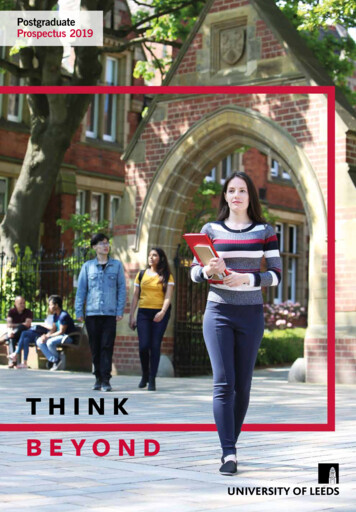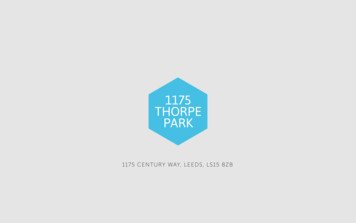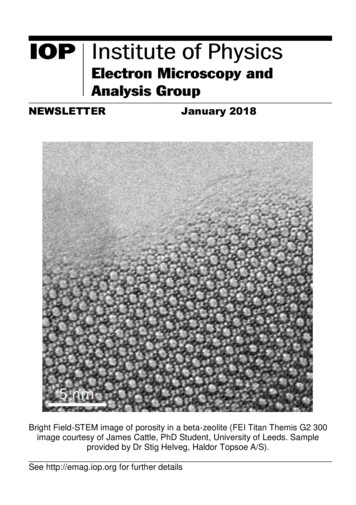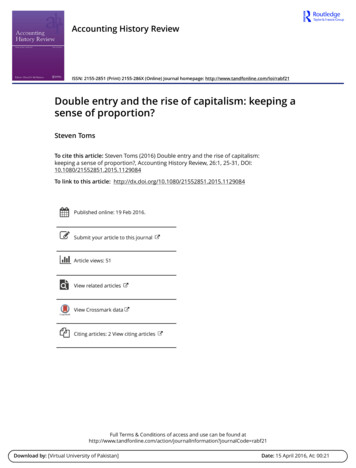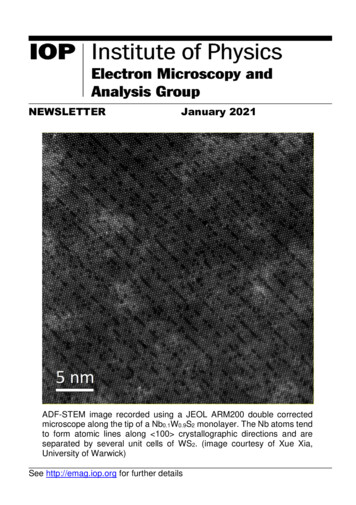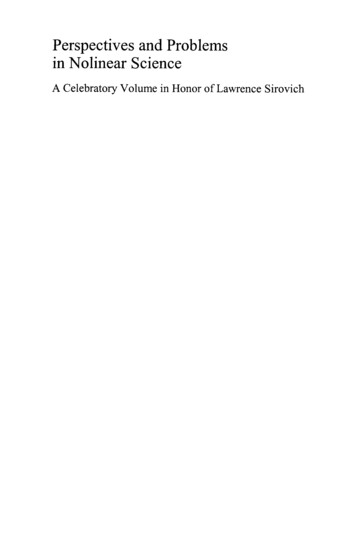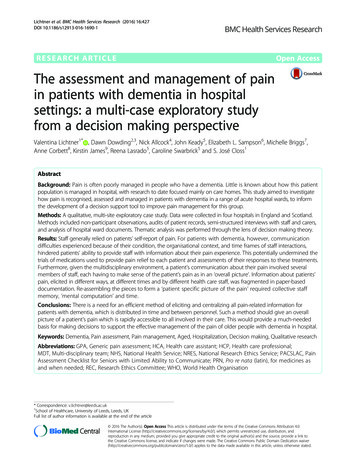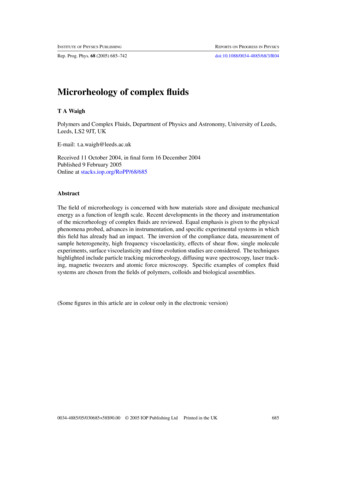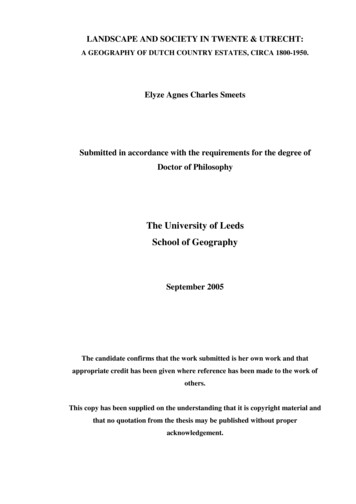
Transcription
LANDSCAPE AND SOCIETY IN TWENTE & UTRECHT:A GEOGRAPHY OF DUTCH COUNTRY ESTATES, CIRCA 1800-1950.Elyze Agnes Charles SmeetsSubmitted in accordance with the requirements for the degree ofDoctor of PhilosophyThe University of LeedsSchool of GeographySeptember 2005The candidate confirms that the work submitted is her own work and thatappropriate credit has been given where reference has been made to the work ofothers.This copy has been supplied on the understanding that it is copyright material andthat no quotation from the thesis may be published without properacknowledgement.
AcknowledgementsI would like to thank the School of Geography at the University of Leeds for funding thisresearch project and for its academic support. In particular, I would like to thank my supervisorsRobin Butlin and Martin Purvis for their advise, encouragement and critical discussions over thelast four years. It has truly been a wonderful experience working with such an amazing team.Thanks also to the many people who have helped me with gathering information. The estateowners in Utrecht and Twente for allowing me to visit their homes and go through theirpersonal archives. The archivists and librarians for making the search for documentary evidenceeasier, particular the people at Kadaster Overijssel. The scholars of various disciplines for ourinteresting discussions on historical geography and landscape aesthetics, especially Hans Renes(my former supervisor at the University of Utrecht) and Adriaan Haartsen (my boss andcolleague at Bureau Lantschap).I would like to thank my fellow students Alison and Hazel for the cups of tea and the talks aboutgeography, PhD’s, and life in general. Thanks for being such good friends.To my family and friends, thank you for your friendship, encouragement and interest. Specialthanks to my parents Jos and Gerdie for always supporting me and believing in me. It is in mychildhood, travelling with you, Alexandra and Mervyn through the hills and valleys that I firstdiscovered my love for landscape and history.I want to dedicate this work to my best friend and husband, Martijn. Thank you for alwaysbeing there for me, for keeping me calm in hectic times and most of all for your love.i
AbstractThe thesis presents new insights into the development, organisation and spatial distribution ofcountry estates established between 1800 and 1950 in the province of Utrecht and the region ofTwente in the Netherlands. During this time period numerous country estates were built: inUtrecht almost 100 and in Twente over 80, the majority of which were built for newly wealthywhose origins lay in commerce, finance and industry. In Utrecht the new landowners werelargely financial businessmen from Amsterdam, while in Twente the majority were textileindustrialists from the region itself.The emergence of such a group of ‘nouveaux riches’ who chose to invest parts of their newmoney in the acquisition of land was not confined to the Netherlands, but was apparent in manywestern European countries, including Britain, Belgium and Germany. The study of Dutchindividuals thus represents a particular dimension of a broader change in European societyduring the nineteenth century, a society that was increasingly marked by processes ofindustrialisation and urbanisation. The thesis therefore incorporates an international comparisonbetween the textile industrialists in Twente and their counterparts in West Yorkshire, England.Three key themes structure this thesis, namely ‘landownership’, ‘estate building’ and ‘landscapedesign’. The first theme deals with who the new landowners were, what enabled them to investin land and what their motivations have been for such investments. The second theme focuseson the spatial patterning of the new country estates and the manner in which they have beenestablished. The third theme is related to the use made of the land and how the new landownerslaid out their properties. Through a geographical approach this thesis aims to bring new insightsinto the themes and reveal the ways in which they have influenced each other.This geographical approach is largely based on Dutch and Anglo-American historicalgeographical traditions of landscape study, incorporating a variety of methods, techniques andways of seeing. This meant that the estate landscapes have been studied both as physical entitiesthat can be mapped and as representations of a culture group or individuals. As such the thesisalso presents a framework for future research on country estates.ii
ContentsAcknowledgementsiAbstractiiContentsiiiList of TablesviiiList of FiguresixAbbreviations and ConversionsxiiiChapter 1. The Geography of Landownership and the Aesthetic LandscapeIntroduction11.1Thesis Themes and Questions31.2Study Area41.3Intellectual Context: Landscape in Layers6Landscape as a Physical Entity1.46Landscapes of Meaning and Representation11Layers of Meaning14Thesis Structure16Chapter 2. Landownership, Estate Building and Garden DesignIntroduction192.1192.2Landed Estates and their OwnersEstate Building and the Changing Nature of Landowners20The Division of Wasteland27Garden Fashions in the Netherlands, 1750-195029Aesthetic Geometry30The Desire for the ‘Natural’34Return of Geometry41Summary & Conclusions44Chapter 3. Methodologies and SourcesIntroduction473.1Cartographic Material3.2Archival Material51Estate Designs and Views51Photographs53Historical Printed Material55Personal Correspondence (Letters)56iii
3.3Records of Hunting and Shooting56Estate Accounts57Tax Registers57The Cadastre, 183258The use of the cadastral ledger in this research593.4Fieldwork613.5English Sources613.6Methodological Approaches63The use of GIS in historical geographyConclusions6466Chapter 4. Twente and Utrecht: An Historical-Geographical OverviewIntroduction684.1684.2TwentePhysical Setting68Agricultural Systems70The Marken of Twente and their Abolition72Castles and Country Estates75The Industrialisation of Twente78Utrecht80Physical Setting80Agricultural Systems82Communal lands and the division of the meenten84Castles and Country Estates85Summary & Conclusions90Chapter 5. The New Landed EliteIntroduction925.1The Emergence of New Money925.2Identifying the New Landed Elite945.3Origins and Characteristics99Geographical origins and local links99Sources and scales of wealth100Urban and rural connections103Motives for land investment105Relation to nobility106Intermarriages and social coherence108Summary & Conclusions110iv
Chapter 6. Continuity and Change in the Distribution of Country EstatesIntroduction1126.11126.2New Country Estates from 1800 onwardsExisting Pattern of Landownership117Travel, Transport and Communication120The Physical Landscape123Land Availability and Privatisation of Common Land125Social Network126The Process of Creating an Estate130Purchasing an Existing Estate131The Purchase of Land and the Construction of a Temporary Building133The Purchase of Land and the Construction a Country House136The Transformation of a Landed Property Initially Acquired forIndustrial Use into a Recreational Retreat137Estate Subdivision and the Construction of New Properties138Combining Typologies In Practice139Case study: The Blijdenstein family139Summary & Conclusions141Chapter 7. The Aesthetics of Estate LandscapesIntroduction1447.11447.27.3Parks and Gardens: Adapting New FashionsCase Study: Het Amelink, Lonneker/ Enschede146Case Study: Molenbosch, Zeist148Case Study: Huis te Maarn, Maarn150Case Study: Egheria, Oldenzaal152Case Study: De Boekel, Enschede154Case Study: De Hooge Vuursche, Baarn156Fashions at Nouveaux Riches Estates158Case Study: Weldam, Delden159Nouveaux riches vs. Nobility160Diffusing New Garden Fashions161Travel162Publications – guides and pattern books164Publications - text books165Publications – magazines168Exhibitions171The Pioneers: Professionals and Patronsv173
7.4Designing a Region176Summary & Conclusions181Chapter 8. Leisure in the LandscapeIntroduction1838.1Experiencing Parks and Gardens1848.2Aspects of Hunting and Shooting1878.3Beauty and Utility1968.4The Price of Taste199Summary & Conclusions202Chapter 9. Country Estates of Industrialists: An International ComparisonIntroduction2049.1The West Yorkshire Textile Industry2049.2The New Landed Elite of West Yorkshire2079.3The Distribution Pattern of New Country Estates, 1800-1950212Travel, Transport and Communication213Existing Landownership and Land Availability216The Physical Landscape2189.4Purchasing Existing Estates2209.5Leisure in the Landscape2229.6Aesthetics of the Estate Landscape225Summary & Conclusions231Chapter 10. Conclusions10.110.2Comparisons between Utrecht and Twente234Landownership234Estate building236Landscape design238Reflection on the Intellectual Framework240AppendicesI:The New Country Estates of Twente, 1800-1950, with their owners and dateof establishment.II:243The New Country Estates of Utrecht, 1800-1950, with their owners and dateof establishment.III:246The New Country Estates of West Yorkshire, 1800-1950, with their ownersand date of establishment.250vi
IV:The Commissions of Professional Designers at Nouveaux Riches Estates (i.e.created 1800-1950) in the Province of Utrecht and the Region of Twente, theNetherlands.V:253Time Lines of the Main Garden Styles and Designers in the Netherlands,1800-1950.VI:257Time Lines of the Major Phases in Industry for the Netherlands(specifically Twente) and England (specifically West Yorkshire)258Bibliography and other sourcesI:Interviews, conversations and meetings259II:General Dutch archival sources260III:Archival sources for Twente263IV:Archival sources for Utrecht271V:Archival sources for West Yorkshire279VI:Internet and cd-rom sources284VII:Published primary and secondary literature285vii
List of TablesTablePage3.1Summary of key cartographic sources473.2The ten greatest individual landowners in Twente, 1832604.1The number of marke divisions in the Province of Overijssel andTwente, 1819-1879745.1The new landed elite of Utrecht with source of money and geographical origin985.2The new landed elite of Twente with source of money and geographical origin998.1The amount of game killed annually by Helmich Blijdenstein, for the years9.11884-1904193A sample of West Yorkshire’s new landed elite208viii
List of FiguresFigure1.1PageOne of the statues of the Temple of the Four Winds in the gardens atCastle Howard, East Yorkshire, overlooking the agricultural estate1.21The position of the province of Utrecht and the region of Twente inthe Netherlands52.1The medieval castle Oudaen along the Vecht202.2Sterreschans estate, created along the river Vecht in 1688222.3Example of a Dutch garden, as given by Van der Groen, 1668322.4Example of a French garden, as given by Van der Groen, 1668322.5Venus fountain at Het Loo estate332.6Pine trees and Swiss bridge at Aardenburg estate, 1903372.7Design by D. Wattez for Het Stokhorst near Enschede, 1889382.8Hugo Poortman’s design for flower borders in the ‘French garden’at Twickel, 18983.143Detail of the Hottinger map, showing the town of Delden andTwickel estate483.2Detail of a minuutplan showing Castle Zuilen493.3Het Stroot estate near Enschede, property of the Van Heek family543.4ArcView database showing specifics of all landed estates createdin the province of Utrecht653.5ArcView map of all landed estates created in the province of Utrecht654.1The physical geography of Twente694.2Plaggen soils714.3The municipalities of Lonneker and Stad Enschede, showing the presenceof plaggen soils (essen) and wastelands owned by various marken, 1832734.4The medieval castles and manors of Twente754.5The castle of Twickel estate near Delden774.6The factory of the Van Heek family along the railroad Enschede-Gronau,circa 1960794.7The physical geography of the province of Utrecht804.8The Utrechtse Heuvelrug near Rhenen814.9The medieval castles and manors of Utrecht86ix
Figure4.10PageThe location of seventeenth- and eighteenth-centuries estates in theprovince of Utrecht884.11Oostbroek estate near De Bilt895.1The areas of geographical origin and recreational investment of Dutchnouveaux riches in the nineteenth century945.2The lijst van hoogstaangeslagenen of the province of Utrecht, 1853965.3Willem Benjamin Blijdenstein, painted by Jan Veth in 19091015.4Johannes Theunis Roessingh Udink, painted by Jan Adam Kruseman in 18441015.5Hydepark mansion, at the start of the twentieth century1045.6Gerrit Jan van Heek’s family in 1898, including the partners of someof his children1096.1AThe nouveaux riches estates of Twente1136.1BInlay map of the nouveaux riches estates around Oldenzaal and Enschede1146.2AThe nouveaux riches estates of Utrecht1156.2BInlay map of the nouveaux riches estates near Driebergen, Zeist and Doorn1166.3The distribution pattern of Twente and Utrecht estates before and after 18001186.4The chronological distribution pattern of nouveaux riches estates in Twenteand Utrecht, 1800-19501196.5Hoog Beek en Rooyen estate in Zeist, 18961216.6Berghuisje on the heath lands near Maarn in 1840. The owner, J.B. Stoop,stands on the left1236.7The Hakenberg estate near Oldenzaal1246.8Huis te Maarn estate in the 1920s, with the newly built country house1276.9The estates of the Van Heek, Blijdenstein, Ter Kuile and Gelderman familiesin Twente6.10128The estates created by Gerrit Jan van Heek (1837-1915) and some ofhis children1296.11The Drakestein estate near Baarn1326.12De Hulst estate near Oldenzaal1336.13Examples of garden pavilions and tea houses in Twente: huntingsociety Enschede, Oldenzaalse Veen and Bonenkamp/ Hooge Boekel6.14134Huis te Maarn estate in the 1913, with the teahouse ‘De Verrassing’(The Surprise)1356.15The Ruiterberg estate near Doorn1366.16Schuttersveld estate near Enschede1376.17The landed property of B.W. Blijdenstein in Lonneker, 1832140x
Figure6.18PageThe landed property of Benjamin Willem Blijdenstein in 1854 with its valueper hectare1407.1Aerial photo of Amelink estate, 20051467.2The Molenbosch estate, 18691497.3Huis te Maarn estate in the 1920s1507.4Huis te Maarn estate. Winter 20031517.5Aerial photograph of Egheria estate, circa 1911. Seen from the southeast1537.6Aerial photograph of Egheria, 2005. Seen from the northwest1537.7De Boekel estate in the 1940s1557.8The main house at De Boekel estate seen from the southern wild flowerborder, circa 19801567.9Bird’s eye view of Hooge Vuursche estate near Baarn1577.10De Hooge Vuursche estate seen from the south1577.11Petzold’s design in landscape style for Weldam estate was not executed (1878) 1607.12The geometric design for Weldam estate by André was executed, 1885-861607.13Designer Leonard Springer in the German Spessart-mountains1637.14Folly chapel or dovecote of Sandwijck estate, De Bilt1657.15Illustration from A.J. van Laren’s Decoratieve tuinbeplanting (1913)1677.16Advertisement from D.F. Tersteeg1707.17The exhibit of H. Copijn & Son for the Groote Bloemententoonstelling(Large Flower Exhibition) in Amsterdam, 19231727.18Designer Leonard Springer in one of his creations: Kalheupink near Oldenzaal 1787.19The geographical distribution of gardens designed by the professionaldesigners D. Wattez, P.H. Wattez and L.A. Springer at nouveaux richesestates in Twente7.20179The geographical distribution of gardens designed by the professionaldesigners J.D. Zocher jr., H. Copijn and L.A. Springer at nouveaux richesestates in the province of Utrecht1808.1Family Neervoort van de Poll in the gardens of Beukenstein1838.2Leisure at Zwitserse Huis near Leersum1858.3The arboretum at Poort Bulten1878.4The hunting permit for Count Bentinck of Amerongen, 1893-94. It allowedall kinds of hunting except that with hounds and with falcons. Of all permitsthis type was issued the most1898.5Detail of the hunting permit ledger of the Amersfoort district in 19031908.6Hunting party with G.J. van Heek and sons at Lankheet, 1898191xi
FigurePage8.7G.J. van Heek at Het Stroot, late nineteenth century8.8The location and name of hunting grounds mentioned in Helmich193Blijdenstein’s hunting diary, 1879-19051958.9The hunting lodge at Lankheet estate in 18991968.10Cows graze the lawn at Nieuw-Sterkenburg estate, 18691988.11The Hooge Boekel estate, depicted by Anco Wigboldus (1977)1998.12Veldheim estate in 18692019.1West Yorkshire2059.2The industrial town of Halifax with Dean Clough Mill of the Crossleyfamily on the foreground (1864)2069.3The model village of Akroydon in Halifax2119.4Estates established during the nineteenth and twentieth centuries in thepresent-day county of West Yorkshire2149.5The estates established around the spa town of Ilkley, 1800-19502159.6West Yorkshire estates established after 1800 in relation to the major urbancentres9.7216The distribution of country estates and houses in West Yorkshire –distinguishing those established before and after 18009.8Ordnance survey map showing the estate of Dobroyd Castle, property ofJohn Fielden, situated on the steep relief overlooking the Calder Valley9.9217219Gentry and noble estates purchased by newly wealthy in nineteenthcentury West Yorkshire2219.10Castle Carr estate in 18892249.11Roundhay Park near Leeds2289.12Heathcote, Ilkley, was designed by Sir Edwin Lutyens in a suburbanenvironment. The use of the natural relief and the creation of vistas gavethe feeling of spaciousness230xii
Abbreviations and ConversionsAbbreviationsHCO:Historisch Centrum Overijssel in ZwolleHUA:Het Utrechts Archief in UtrechtSCL:Special Collections Library in WageningenWKAU:Werkgroep Kadastrale Atlas UtrechtWYAS Calderdale:West Yorkshire Archive Service in CalderdaleWYAS Leeds:West Yorkshire Archive Service in LeedsYAS:Yorkshire Archaeological Society in LeedsConversions1 hectare 2.471 acres1 acre 0.4047 hectare1 kilometre 0.62 miles1 mile 1.61 kilometre1 guilder (1830) 12 guilders (1990) or 5.50 euros (2005)1 guilder (1900) 17 guilders (1990) or 7.80 euros (2005)1 guilder (1990) 0.45 euros (2005)1 euro (2005) 2.2 guilders (in 1990)1 euro (2005) 0.68 pound sterling (2005)The value of money1 pound sterling (2005) 1.47 euros (2005)xiii
Chapter 1.The Geography of Landownershipand the Aesthetic LandscapeINTRODUCTIONFor many centuries the cultural histories and landscapes of Europe have been influenced by thepresence of great landowners. Their landed estates and country houses with parks and gardensformed key points of intersection between practical aspects of economic management and aestheticlandscape design (Figure 1.1), and as such dominated much of the countryside. The power andprivileges deriving from landownership often ensured a social and political importance for estatesand their owners, and consequently the influence of this kind of landownership was not confined tothe borders of the estates. Frequently, great landowners invested in transport improvements,stimulated changes in agriculture and field systems, and restored, built or planned urbansettlements, churches, schools and alms houses.Figure 1.1: One of the statues of the Temple of the Four Winds in the gardens at Castle Howard, EastYorkshire, overlooking the agricultural estate.Photo by author, July 2002.1
Chapter 1: The Geography of Landownership and the Aesthetic LandscapeDuring the course of the nineteenth century many western European countries, including theNetherlands, Great Britain, Belgium, Germany and France, witnessed the rise of a new class ofwealthy borne of finance, commerce and industry. These individuals, often referred to as ‘nouveauxriches’, were people for whom land was not their main source of income. It was nevertheless notuncommon that they invested their riches in the acquisition of land, creating a country estate withparks and gardens, sometimes also with agricultural land. Compared to the established elite theirlanded property was generally less extensive, in part reflecting a change in attitude towardslandownership. Country estates of these newly wealthy were more likely to be predominantlyrecreational in character and often were designed to illustrate the owner’s new status. The nouveauxriches possibly even desired to emulate greater landowners through the creation of fashionableparks and gardens. Economic functions like agriculture, forestry and mining were of lessimportance; their source of money lay elsewhere, in financial, commercial or industrial enterprisesin urban centres. As such these individuals represent one dimension of a broader change in thesocial, economic and political life of Europe, greatly marked by industrialisation and urbanisation.Different disciplines like garden history, social-economic history, architectural history, genealogyand geography, have studied the emergence of the newly wealthy and their country estates, askingquestions of scale, location, aesthetic design, ownership, economic profit, and recreation. Usually, aparticular discipline focuses on a specific aspect of country estates and estate ownership, offeringmuch detailed information of great value. However, such an approach can also result in thefragmentation of knowledge, which is unfortunate as issues of landownership, as mentioned above,are often related. A geographical approach, however, can overcome this problem as ‘(historical)geography is, above all, a hybrid discipline’ (Heffernan, 1997, p. 2), ‘an integrative discipline’(Hart, 1982, p. 1) that has a tradition of synthesis, of bringing things together. The value of ageographical approach, therefore, lies in the fact that it can combine approaches and data fromdifferent disciplines, thereby adding new insights through a spatial view. It focuses upon the waysin which different actors and forces interact in particular places, shaping the character of theseplaces yet at the same time being shaped by them. Furthermore, it explores how developments in aparticular place are influenced by wider processes at a regional, national and even internationallevel.Therefore, by taking a geographical approach, this research will not only look at particular places,but also at the space in which these places appear: the social, economic and political contexts of theregion. It furthermore analyses the spatial distribution of various aspects of nouveaux richeslandownership, including the developing chronology of country estates’ locations, the employment2
Chapter 1: The Geography of Landownership and the Aesthetic Landscapeof particular designers and the availability of land. A geographical viewpoint thus enables theresearcher to deal with such issues at various scales: from international to local.1.1 THESIS THEMES AND QUESTIONSThis doctoral project focuses on three broad themes, namely Landownership (the nature and originof nouveaux riches landowners), Landed Estates (creation, distribution and location) andLandscape (aesthetics and functionality). The thesis’s structure is based on refining these themesand linking them together. For each theme a series of questions have been posed, which will beanswered through the course of the thesis.Landownership: Who were the nouveaux riches landowners? What were the means andopportunities that allowed these landowners to invest in land? What were their motivations andaspirations for land investment? How did the emergence of a new elite change the distribution oflanded estates? The rise of a new class of landowners (their backgrounds, motivations andopportunities) will mostly be dealt with in Chapter 5.Landed estates: Where were the nouveaux riches estates located? How can this spatial andtemporal distribution pattern be explained? What mechanisms have driven changes in this pattern?In what manner did the newly wealthy obtain their own country estate (i.e. by purchasing anexisting property or by creating it themselves)? How can the various processes of estate building beexplained? These questions are focused upon in Chapter 6. It comprises the regional study andmapping of continuity and change in the spatial and temporal patterns of landownership and landedestates.Landscape: What is the appearance of the estates? Was there a uniformity in design either becauseland was devoted to different uses within the estate or because particular parts of the estate carriedthe imprint of landscape design fashions of particular eras? How were new garden fashionsdiffused? Who were the key players in designing and diffusing new fashions? What choices ofdesigners and designs did the nouveaux riches landowners make? How did these choices relate tobroader trends in garden design and to their own social network? Chapter 7 elaborates on thesequestions.How was the designed landscape used and experienced by the new landowners? Did the nouveauxriches landowners resemble the established elite in their conspicuous consumption or were theydistinctive in a particular way? These issues of landscape use are dealt with in Chapter 8.3
Chapter 1: The Geography of Landownership and the Aesthetic LandscapeThese questions challenge existing ideas about the location, use and appearance of nineteenth andtwentieth-century estates by combining issues of landscape, society and taste at differentgeographical scales. The incidence of newly-created estates and aspects of their landscape designand conspicuous consumption will, for instance, be explored in relation to broader trends in nationaland international garden design, but also to the diversity in landscapes and the character and socialnetwork of the estate owners. Furthermore, instead of only identifying well-known histories offashions in gardening on a national level, this thesis will also examine the various spatial andtemporal patterns of how these new ideas circulated through the different regions and social groupsof landowners.1.2 STUDY AREAFor this doctoral project two particular regions of the Netherlands have been chosen in which newestate development occurred in the nineteenth and twentieth centuries, namely the region of Twenteand the province of Utrecht (Figure 1.2; Chapter 5). This new estate building was initiatedparticularly by newly wealthy families with fortunes based on finance, industry and commerce.Whereas in Utrecht the majority of nouveaux riches came from banking and trade, in Twente thisgroup was predominantly from the local textile industry. By choosing these particular regions, thisthesis thus incorporates the study of two different kinds of newly wealthy. Another reason forfocusing on Utrecht and Twente was that these regions include areas of important estatedevelopment within a diverse series of environments (upland, woodland, pastoral agriculture andlowland arable). The differences in landscape, economy and the nature of new landowners, asevident in the two regions, will be explored in more detail throughout the thesis, investigatingwhether such issues played a role in determining the character and location of nouveaux richesestates.The Twente industrialists will be further investigated through the comparison with a similar socialgroup in the present-day county of West Yorkshire in England (Figure 9.1; Chapter 9). Thiscomparison aims to explore the motivations, actions and taste in landscape aesthetics of theseindividuals, revealing whether the Twente industrialists were unique in their actions and choices orwhether they resembled other newly wealthy in Europe.As such the newly wealthy in these Dutch regions are not only interesting in their own respect, butalso as a representation of a new group of landowners seen throughout nineteenth-century westernEurope. The discussed processes of industrialisation and urbanisation that invoked changes in termsof society, wealth, ownership and political power in these regions also occurred in countries like4
Chapter 1: The Geography of Landownership and the Aesthetic LandscapeGreat Britain, Belgium and Germany. The rise of a new landowning elite borne of finance,commerce and industry is therefore an European phenomenon, which gives value to a comparisonbetween different countries. Through the study of Dutch examples and the comparison with anEnglish example this thesis gives detailed insights into the backgrounds, motivations and tastes ofsuch individuals, allowing analyses of the impact of their presence on landscape and society.TwenteUtrechtN04080120160 KilometersFigure 1.2: The position of the province of Utrecht and the region of Twente in the Netherlands.It has to be noted, however, that the landed property of nouveaux riches landowners was generallyless extensive than that of the existing landed elite (both nobility and non-titled estate owners), andthat between various European countries the average size of a country estate differed greatly.Within British studies, for instance, an estate has often been described as ‘any land holding of atleast 3,000 acres [or 1200 hectares]’ (Bettey, 1993, p. 11). Rubinstein (1981, 1987, 1992) andCannadine (1990, 1994) have used similar typologies and criteria, and it seems that British researchon country estates and landownership focuses largely on landed properties of those proportions. Bydoing so these scholars exclude from consideration any exploration of the importance of smallercountry estates created by the newly wealthy in the nineteenth and twentieth centuries. In particular,5
Chapter 1: The Geography of Landownership and the Aesthetic Landscapethe country estates of merchants, bankers and industrialists who did not rely upon their estate forincome, could be relatively small. Yet despite their modest size, these entities had a great impact onthe landscape and society as representations of wealth, power, and taste and demonstration ofaesthetic value. In general Dutch landed estates were much smaller than their British counterparts,and it appears that the country estates created by the Dutch newly wealthy were particularly small insize, often not bigger than 10 hectares (which has been used as a minimum in this thesis).The great majority of the estates discussed in this thesis were created by people who have beendubbed ‘nouveaux riches’. T
8.3 Beauty and Utility 196 8.4 The Price of Taste 199 Summary & Conclusions 202 Chapter 9. Country Estates of Industrialists: An International Comparison Introduction 204 9.1 The West Yorkshire Textile Industry 204 9.2 The New Landed Elite of West Yorkshire 207


